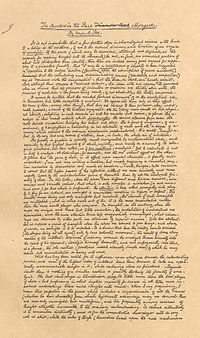One of my favorite authors in Edgar Allan Poe, not because I like horror, but because he wrote my favorite poem, “The Raven”. So it caught my eye when I read that April 20, 1841, was considered the first appearance of the modern detective story, “The Murders in the Rue Morgue” by… Edgar Allan Poe.
According to The Writers’ Almanac of April 20th (http://writersalmanac.org/page/4/) —
It first appeared in Graham’s Lady’s and Gentleman’s Magazine, and Poe had been serving as the magazine’s editor since February. He received $56 over and above his salary, which was a high price at the time.
In the story, a mother and daughter have been brutally murdered in a fourth-floor room that has been locked from the inside. Witness accounts are contradictory, but all recall overhearing a voice in a language that they didn’t speak or even recognize. An arrest is made, but the suspect clearly has had nothing to do with the murders. A clever and eccentric young man hears of the murders and offers his services to the bumbling prefect of police.
Poe’s narrator describes the detective in question, Monsieur C. Auguste Dupin: “This young gentleman was of an excellent – indeed of an illustrious family, but, by a variety of untoward events, had been reduced to such poverty that the energy of his character succumbed beneath it, and he ceased to bestir himself in the world, or to care for the retrieval of his fortunes. By courtesy of his creditors, there still remained in his possession a small remnant of his patrimony; and, upon the income arising from this, he managed, by means of a rigorous economy, to procure the necessaries of life, without troubling himself about its superfluities. Books, indeed, were his sole luxuries, and in Paris these are easily obtained.” Dupin eventually solves the crime: an orangutan, armed with a straight razor, had committed the murders. The ape had entered the locked room by scaling the building and coming in through the window.
Dupin appeared again in two more Poe stories: “The Mystery of Marie Roget” (1842) and “The Purloined Letter” (1844). He also inspired many of the famous literary detectives we’re familiar with today, including Agatha Christie’s Hercule Poirot, and Arthur Conan Doyle’s Sherlock Holmes. Some readers felt that Holmes was a little too much like Dupin, in fact. In the preface to an 1899 edition of the story, Henry Austin takes the opportunity to call out Poe’s imitators: “Perhaps the most gaudy example of this kind of freebooter is furnished by Dr. A. Conan Doyle. His alleged detective, Sherlock Holmes, out of whom he has made so undeserved a reputation, will be found, by anyone who takes the trouble to compare Holmes’s exploits and methods with those of Dupin, about the crudest and most contemptible imitation of a strong original in all literary annals. Not satisfied with taking the general outlines of this character, Dr. Doyle has even reproduced some of the minor incidents of his methods, thereby showing a paucity of invention that would have brought a blush to the cheek of that prince of dime novelists, the late Harlan P. Halsey.”
There is a detailed discussion of this story on Wikipedia (https://en.wikipedia.org/wiki/The_Murders_in_the_Rue_Morgue). The photo is a facsimile of Poe’s original manuscript, and was from the Wikipedia entry.

